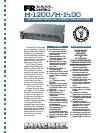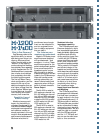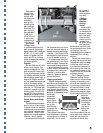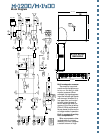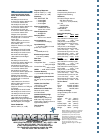
3
Each channel
has an inde-
pendent gain
control with
40 detents for
accurately
setting and
matching the
gain between
channels. The
gain controls
are calibrated
in dB (from
off to 30) and
in volts (with
indications of
1V, 2V, and 3V).
Six discrete
LEDs are used
to indicate signal level for
each channel, including a
signal present LED, indicators
at –20, –9, –6, and –3dB
below full power, and an
overload LED to indicate
when the output has reached
the clipping point.
Outputs.
The M•1200 and M•1400
differ in their output con-
nector configurations. They
both come with heavy-duty
5-way binding posts, which
can accept standard double
banana plugs, spade lugs, or
bare wire (Export versions
will not accept banana plugs
due to European safety
requirements). The M•1200
also has 1/4" TS phone jack
outputs in parallel with the
binding posts. The M•1400
comes with Neutrik brand
Speakon
®
connectors in par-
allel with the binding posts.
Stereo, Mono and Bridge
modes.
The amplifiers can be oper-
ated in one of three modes.
In stereo mode, the amplifier
operates with two inputs and
two outputs. It accepts sepa-
rate channel 1 and 2 input
signals, and outputs separate
channel 1 and 2 signals.
In mono mode, the ampli-
fier operates with one input
and two identical outputs. It
accepts an input signal through
channel 1, and outputs the
same signal at both channel
1 and 2 speaker outputs.
In bridge mode, the ampli-
fier operates with one input
and one output. It accepts an
input signal through channel
1, and combines the power
of both output sections into
a single output, using the
channel 1 positive and
channel 2 positive speaker
output terminals.
Clipping eliminator.
Mackie Designs power
amplifiers use a method of
protecting the amplifier and
the speakers from clipping
that doesn’t affect the low
impedance capablility of the
amplifier. A defeatable limiter
circuit is em-
ployed that
reduces the
input signal
when the out-
put of the
amplifier ap-
proaches the
clipping point.
The moment the output
level drops below clipping,
the limiter turns off and is
effectively “out-of-circuit,”
so it doesn’t
degrade the
audio signal in
any way.
T-Design
Constant
Gradient
Cooling
Tunnel.
Most amplifi-
ers have a fan
in the back that
blows air (along
with dust and
other contami-
nants) into the
inside of the
amplifier, across
the heatsinks
as well as all the other inter-
nal components, and finally
out through the front.
These designs are cheap to
implement, but not very
efficient.
Others use a cooling tun-
nel with the fan at one end.
The problem with this design
is that the heat from the
first transistors warms the
air so that by the time the
air reaches the end of the
tunnel it’s too hot to provide
sufficient cooling.
Our T-Design Constant
Gradient Cooling Tunnel
offers a much more efficient
method of providing cool
air to all the transistors with-
out blowing contaminants
all over its insides. A dual-
speed fan is located in the
center of the amplifier, direct-
ing air from the front of the
amplifier
through a
large intake
manifold into
the cooling
tunnel. The
cool air is
evenly dis-
tributed
from the middle of the tun-
nel to each end, where the
warm air then exits the
amplifier on either side.
Cooling tunnel airflow



